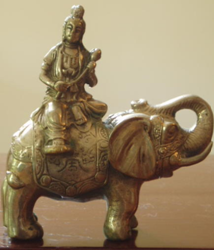| |

Lotus Sutra 4 of 8
10/26/2008
Report by Chang Jie
 So
far, Venerable Guo Chuan has given us a tour of the outer
perimeter of the palace (a colorful metaphor for the Lotus
Sutra). On Sunday, October 26, 2009, we entered the palace
gates, so to speak. So
far, Venerable Guo Chuan has given us a tour of the outer
perimeter of the palace (a colorful metaphor for the Lotus
Sutra). On Sunday, October 26, 2009, we entered the palace
gates, so to speak.
Venerable talked about the importance of commentaries in
Buddhist studies. In fact, the commentaries are one of the
Three Storehouses (tripitaka) of Buddhist texts (the other
two being the sutras and the precepts or vinaya).

Zhuyi (also known as Zhi Zhe), an important Chinese
translator of Buddhist texts, came up with a method of
outlining the Lotus Sutra, which is widely recognized.
According to this scholar monk, the Sutra can be divided
into two sections or parts— the Trace or Provisional Gate
(Chapters 1-14) and the Source or Original Gate (Chapters
15-28). The Trace Gate section can be further divided into
three parts-- the Introduction (Chapter 1), the Orthodox
Teachings (Chapters 2-9) and the Transmission (Chapters
10-14). The Source or Original Door can also be delineated
into three parts—the Introduction (Chapter 15), the Orthodox
Teachings (Chapters 15-17), and the Transmission (Chapters
17-28). The Introduction relates the causes and conditions
for the gathering of the various beings, the Orthodox
Teachings is the dharma of the Buddha and the Transmission
is how the teaching will be transmitted to sentient beings
and the merit that will be attained through transmission.

Venerable introduced the Sutra by talking about the setting,
its characters, and the opening scene. A great light appears
and attracts many followers to the scene. The Buddha is on
Mount Gridhrakuta after having just finished teaching the
sutra titled Immeasurable Meanings. The bodhisattvas
Manjushri (shown on the left) and Maitreya (shown on the
right) have a conversation about the meaning
of this great event. In a past life, Maitreya was a
bodhisattva named "Seeker of Fame" who was lazy and greedy
for fame and profit, but because of his good karmic roots
and merits, will be the future Buddha. Like "Seeker of
Fame", we have many character flaws that we recognize during
our practice. Rather than change our habits, which is very
difficult to do, or change the habits of others, Venerable
encouraged us to think about the path that we want to take
in this lifetime and in future lifetimes and to make a wish
to travel on this path.
In Chapter 2, "Expedient Means", the Buddha tells Shariputra
that the teachings are very profound, deep and difficult to
understand. Shariputra requests the teachings three times,
and the Buddha’s responses are--that wisdom can be conveyed
only from Buddha to another Buddha, that sentient beings in
heaven and on earth will be shocked if they hear it, and
people who are “overbearingly arrogant” * would not accept
the teachings and would fall into hell for rejecting the
teachings of the Lotus Sutra. Finally, after Shariputra's
pleads, the Buddha is moved to preach the Sutra.
At the end of the talk, Venerable encouraged us to attend
the next four weeks of the series so that we may receive the
full benefits of the teachings on the Lotus Sutra.
Note: References to the Lotus Sutra is based on The
Lotus Sutra translated by Burton Watson.
*This refers to monks who claim to be enlightened but are
not.
|
|